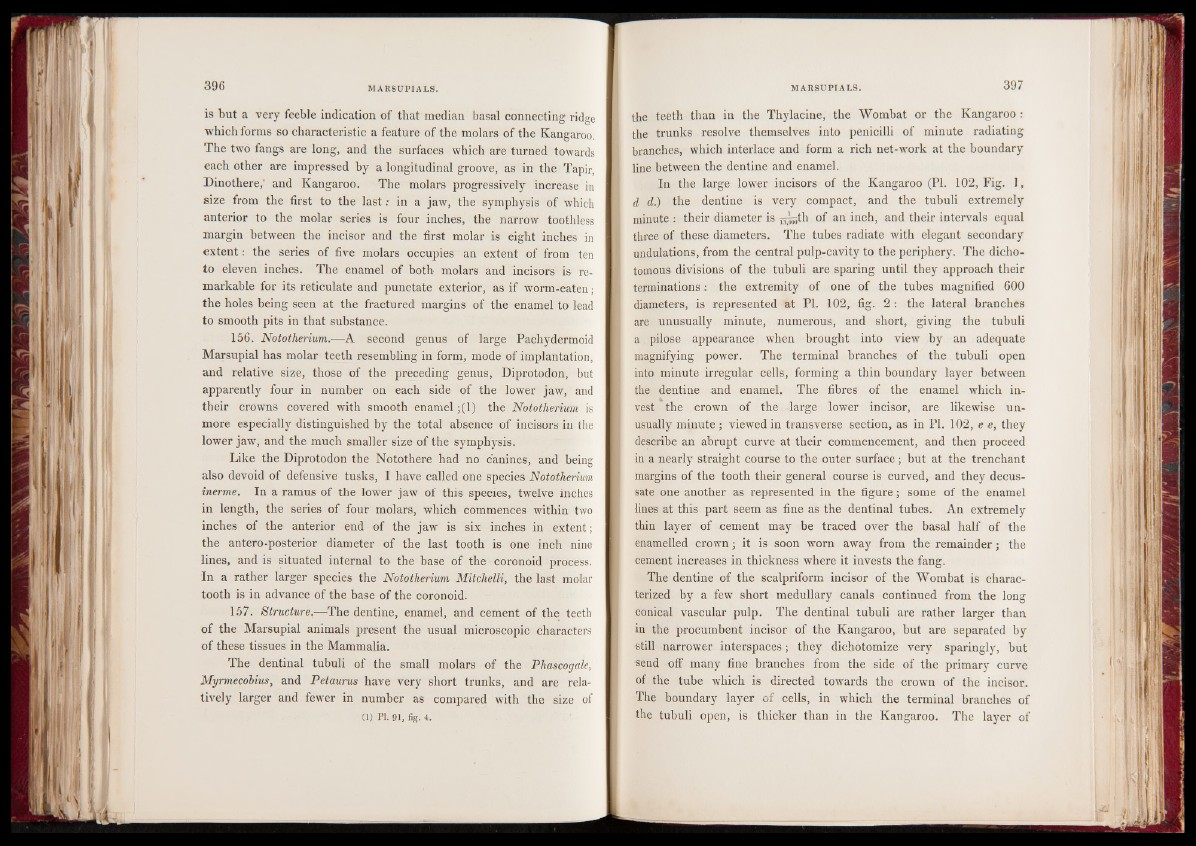
is but a very feeble indication of that median basal connecting ridge
which forms so characteristic a feature of the molars of the Kangaroo.
The two fangs are long, and the surfaces which are turned towards
each other are impressed by a longitudinal groove, as in the Tapir,
Dinothere,' and Kangaroo. The molars progressively increase in
size from the first to the last: in a jaw, the symphysis of which
anterior to the molar series is four inches, the narrow toothless
margin between the incisor and the first molar is eight inches in
extent: the series of five molars occupies an extent of from ten
to eleven inches. The enamel of both molars and incisors is remarkable
for its reticulate and punctate exterior, as if worm-eaten ■
the holes being seen at the fractured margins of the enamel to lead
to smooth pits in that substance.
156. Nototherium.—A second genus of large Pachydermoid
Marsupial has molar teeth resembling in form, mode of implantation,
and relative size, those of the preceding genus, Diprotodon, but
apparently four in number on each side of the lower jaw, and
their crowns covered with smooth enamel ;(1) the Nototherium is
more especially distinguished by the total absence of incisors in the
lower jaw, and the much smaller size of the symphysis.
Like the Diprotodon the Notothere had no canines, and being
also devoid of defensive tusks, I have called one species Nototherium
inerme. In a ramus of the lower jaw of this species, twelve inches
in length, the series of four molars, which commences within two
inches of the anterior end of the jaw is six inches in extent;
the antero-posterior diameter of the last tooth is one inch nine
lines, and is situated internal to the base of the coronoid process.
In a rather larger species the Nototherium Mitchelli, the last molar
tooth is in advance of the base of the coronoid.
157. Structure.—The dentine, enamel, and cement of the teeth
of the Marsupial animals present the usual microscopic characters
of these tissues in the Mammalia.
The dentinal tubuli of the small molars of the Phascogale,
Myrmecobius, and Petaurus have very short trunks, and are relatively
larger and fewer in number as compared with the size of
(1) PI. 91, fig. 4.
the teeth than in the Thylacine, the Wombat or the Kangaroo :
the trunks resolve themselves into penicilli of minute radiating
branches, which interlace and form a rich net-work at the boundary
line between the dentine and enamel.
In the large lower incisors of the Kangaroo (PI. 102, Fig. 1,
d d.) the dentine is very compact, and the tubuli extremely
minute : their diameter is i^ th of an inch, and their intervals equal
three of these diameters. The tubes radiate with elegant secondary
undulations, from the central pulp-cavity to the periphery. The dichotomous
divisions of the tubuli are sparing until they approach their
terminations: the extremity of one of the tubes magnified 600
diameters, is represented at PL 102, fig. 2 : the lateral branches
are unusually minute, numerous, and short, giving the tubuli
a . pilose appearance when brought into view by an adequate
magnifying power. The terminal branches of the tubuli open
into minute irregular cells, forming a thin boundary layer between
the dentine and enamel. The fibres of the enamel which invest
the crown of the large lower incisor, are likewise unusually
minute ; viewed in transverse section, as in PI. 102, e e, they
describe an abrupt curve at their commencement, and then proceed
in a nearly straight course to the outer surface; but at the trenchant
margins of the tooth their general course is curved, and they decussate
one another as represented in the figure; some of the enamel
lines at this part seem as fine as the dentinal tubes. An extremely
thin layer of cement may be traced over the basal half of the
enamelled crown; it is soon worn away from the remainder; the
cement increases in thickness where it invests the fang.
The dentine of the scalpriform incisor of the Wombat is characterized
by a few short medullary canals continued from the long
conical vascular pulp. The dentinal tubuli are rather larger than
in the procumbent incisor of the Kangaroo, but are separated by
still narrower interspaces; they dichotomize very sparingly, but
send off many fine branches from the side of the primary curve
of the tube which is directed towards the crown of the incisor.
The boundary layer of cells, in which the terminal branches of
the tubuli open, is thicker than in the Kangaroo. The layer of